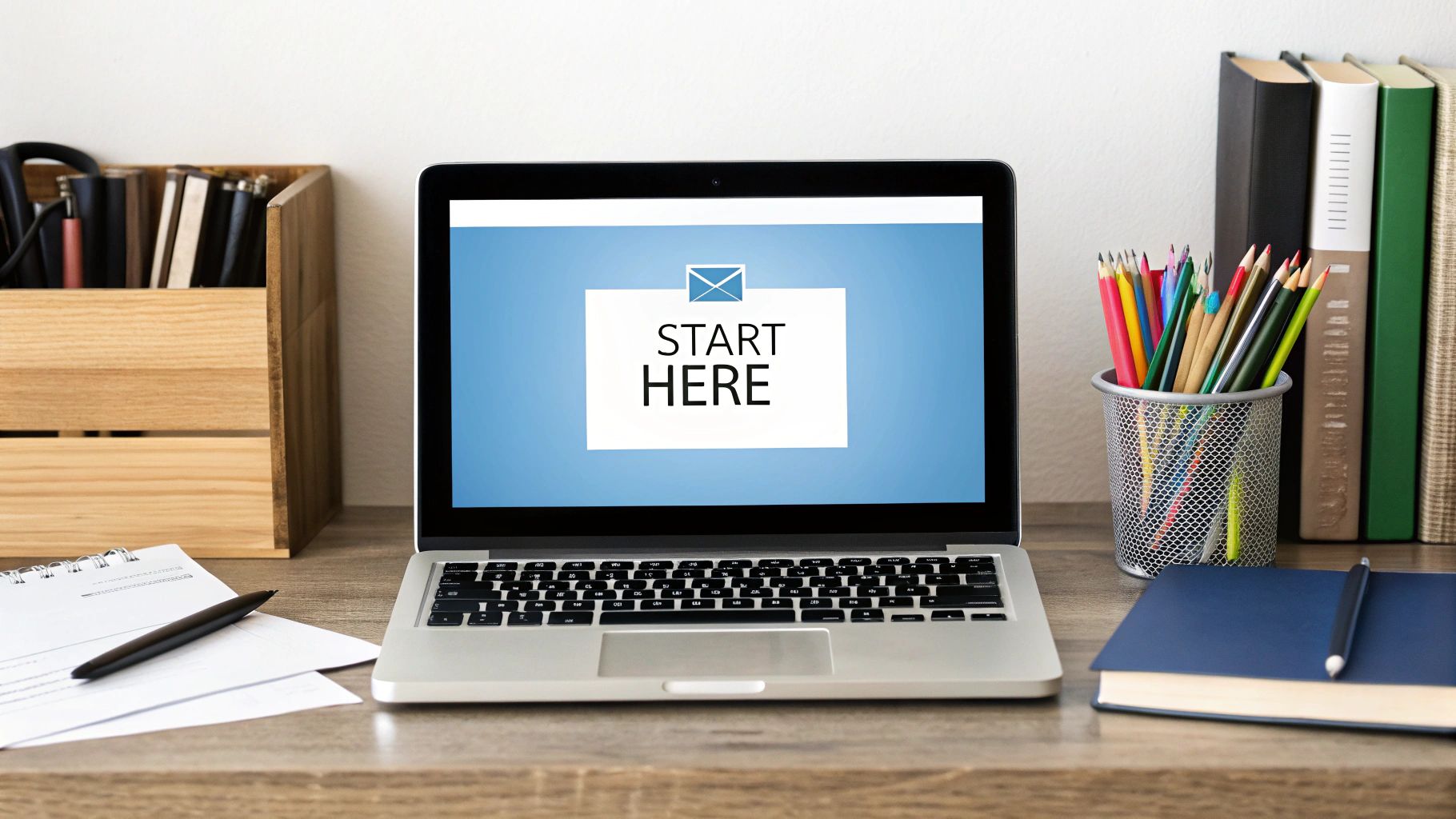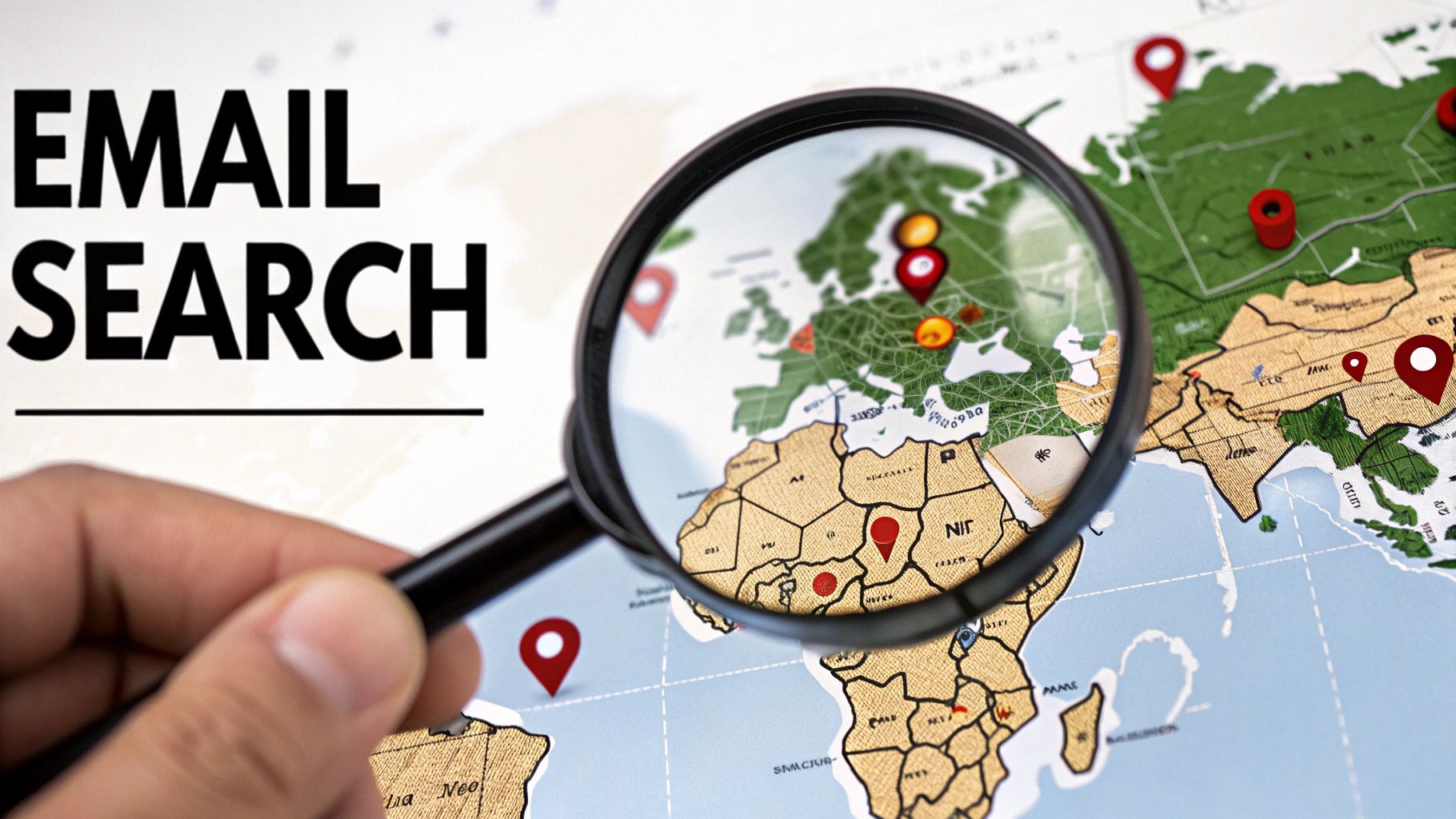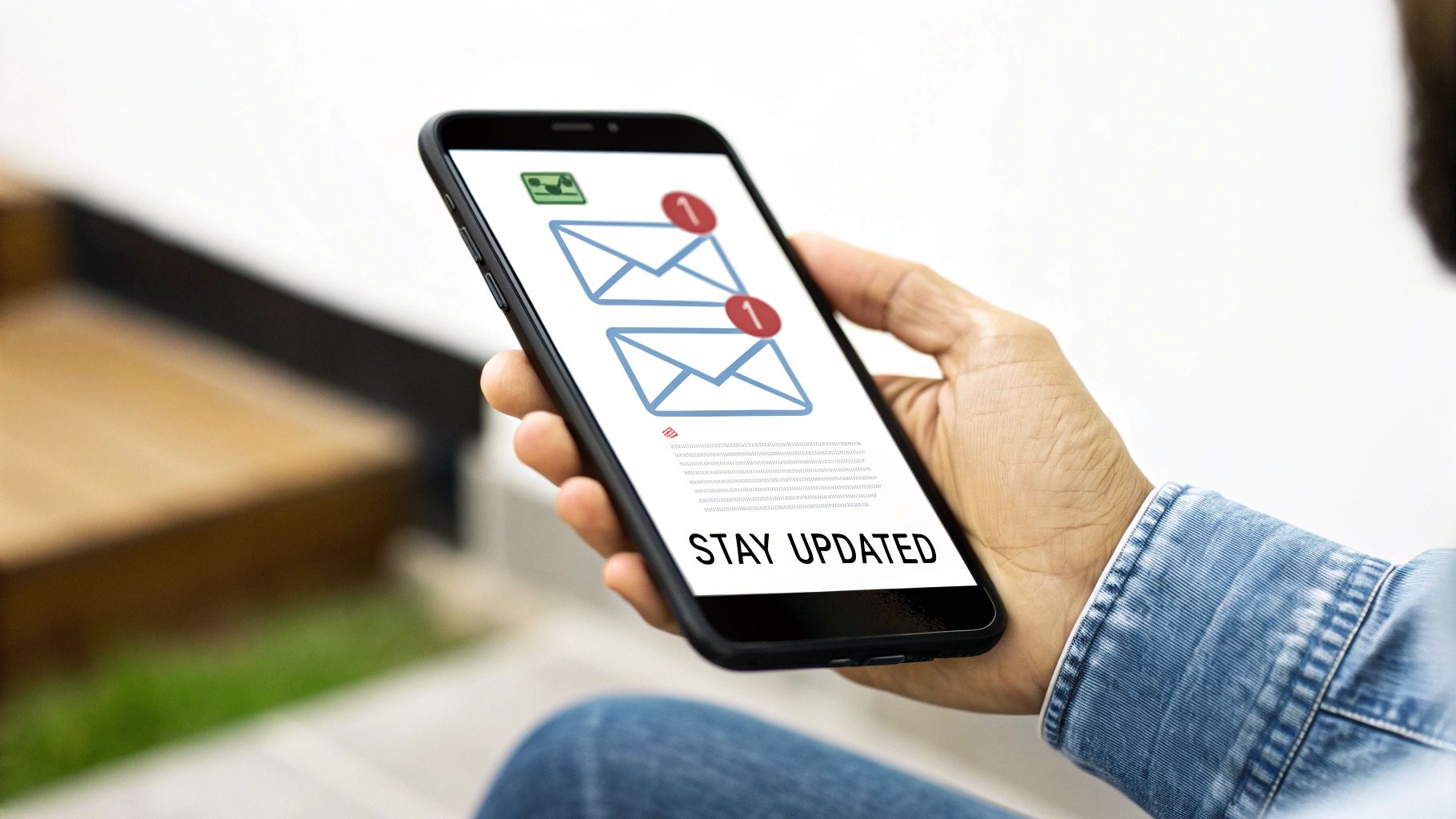Why Finding Email Addresses Is Mission-Critical
Finding the right email address is like having a key that unlocks valuable professional connections and opportunities. In business, email remains the most effective way to build and maintain professional relationships. Despite the rise of instant messaging and social media, email continues to be the standard for formal business communication.
Let's explore some key statistics about email usage worldwide:
| Metric | Value | Impact |
|---|---|---|
| Global Email Users | 4.48 billion | Represents potential reach |
| Population Coverage | 56.8% | Shows widespread adoption |
| Professional Usage | 92% | Primary business tool |
| Growth Rate | 3% yearly | Steady expansion |
The Enduring Power of Email
Email stands out as the backbone of professional communication because it provides formality and record-keeping that other platforms can't match. Key business activities like negotiations, contract discussions, and formal introductions work best through email. It creates a clear paper trail and allows for thoughtful, targeted messaging that helps businesses connect meaningfully with their audience.
Email gives you direct access to decision-makers, helping you bypass gatekeepers when reaching out to important contacts. This direct line of communication proves invaluable for networking, sales, and business growth. According to recent data, there are now 4.48 billion email users worldwide – that's more than half (56.8%) of the global population. Learn more about usage trends here: Email Usage Statistics
The Competitive Edge of Email Discovery
Finding email addresses effectively gives you a real advantage in business. It lets you take the initiative to connect with potential clients, partners, and industry leaders instead of waiting for them to find you. Think about being able to reach the exact person you need to talk to – it opens up countless possibilities for collaboration and growth. For additional insights, check out Our Sitemap.
Industries Thriving on Email Outreach
Many industries rely heavily on email outreach for success. Sales teams use it to nurture leads and close deals. Recruiters connect with candidates to fill positions. PR professionals build relationships with journalists to get media coverage. These examples show how email remains essential across different business sectors.
Building Lasting Relationships Through Email
Smart professionals know that email is more than just sending messages – it's about creating and maintaining valuable connections. A well-written email can start an important professional relationship. When used strategically, email helps build trust, establish expertise, and develop rapport with contacts. Strong relationships built through email often lead to long-term business success.
Mastering Email Pattern Recognition
Finding someone's email address can feel like searching for a needle in a haystack. Understanding common email patterns can make this task much easier. Once you learn the typical formats companies use, you'll be able to predict and find email addresses more effectively.
Common Email Address Formats
Most businesses follow standard patterns for their employee email addresses. The most typical formats combine the person's name with the company domain in predictable ways like [email protected], [email protected], or simply [email protected]. Learning these basic patterns will help you accurately guess email addresses.
Industry-Specific Email Formats
Different business sectors tend to use distinct email formats. Technology companies often use shorter, informal addresses, while financial and legal firms prefer more formal structures. By studying how companies in your target industry format their emails, you can make smarter guesses about addresses you're trying to find.
Understanding Personal Email Preferences
People's email addresses often reflect their preferences and personalities. Some keep it simple and professional, while others may include nicknames. Looking at someone's usernames on social media can give clues about their email format choices. According to recent data, the average person has 1.86 email accounts, contributing to a global total of 8.3 billion email accounts. For more detailed statistics, check out this comprehensive email report from ZeroBounce.
Practice Makes Perfect
The best way to get better at recognizing email patterns is through regular practice. Start by studying email addresses you already know. Look for common elements and variations in the formats. Then test your skills by trying to predict new email addresses based on the patterns you've learned. With time and practice, finding email addresses will become second nature.
Power Tools for Email Discovery
Finding email addresses can be time-consuming, but the right tools can make it quick and simple. Let's explore some of the best email discovery tools that help you connect with the right people faster.
Email Finding Tools: A Comparative Overview
There are several excellent tools for finding email addresses, from basic browser add-ons to full-featured platforms. Here's how the top options compare:
| Tool Name | Key Features | Price | Best For |
|---|---|---|---|
| Hunter.io | Domain search, author finder, bulk tasks | Freemium, paid plans | Individuals, small teams |
| VoilaNorbert | Bulk verification, API access, CRM integrations | Paid plans | Sales teams, recruiters |
| Snov.io | Email drip campaigns, tech stack insights | Paid plans | Marketing automation, lead generation |
| FindThatEmail | Social media search, bulk email finder | Paid plans | Researchers, investigators |
| EmailAddress.ai | Advanced verification, catch-all email support, high accuracy | Paid plans | Businesses focused on high deliverability |
This is just a sample of what's available – explore different options to find what works best for your needs. Learn more about mastering email tools.
Choosing the Right Tool for Your Needs
Think about your main goals when picking a tool. Do you need to find individual email addresses for networking? Or are you looking to build large contact lists for outreach campaigns? Consider your budget too – some tools offer free plans while others require paid subscriptions.
For example, if email verification accuracy is your top priority, EmailAddress.ai delivers 98% accuracy and excels at catch-all email detection. But if you're starting from scratch, search-focused tools like Hunter.io or Snov.io might better suit your needs.
Making the Most of Advanced Features
Many users don't take full advantage of their email finding tools' capabilities. Key features to look for include bulk search for processing large contact lists and CRM integrations that automatically sync new contacts. These extras can save hours of manual work.
Setting Up Team Workflows
When multiple people use email finding tools, good workflow management is essential. Define clear processes, assign responsibilities, and track important metrics like email deliverability. Look for team pricing options and shared account features to optimize costs.
Using Multiple Tools Together
No single tool is perfect – each has unique strengths. Consider using 2-3 complementary tools to improve your success rate at finding the right emails. This approach gives you backup options when one tool falls short, much like having spare keys for important locks.
Advanced Search Techniques That Actually Work
Finding someone's email address can be tricky when you have limited details to work with. But professional researchers and digital sleuths have proven methods that really get results. Even when basic Google searches come up empty, these powerful techniques can help track down the email you need.
Mastering Search Operators
Search operators (also called Boolean operators) let you create focused, precise search engine queries. These special commands tell search engines exactly what you're looking for, filtering out irrelevant results. For example, using site:linkedin.com narrows your search to just LinkedIn profiles, while putting phrases in quotes like "John Smith Marketing" looks for those exact words together.
Here are the most useful search operators:
site:– Limits search to one websiteintitle:– Finds pages with your keyword in the titlefiletype:– Shows only specific file types (PDF, DOCX, etc.)related:– Discovers sites similar to a domain- Quotes (
"") – Matches exact phrases
These work even better in combination. Looking for John Smith in marketing? Try site:linkedin.com "John Smith" "marketing" to zero in on LinkedIn profiles mentioning both terms.
Social Media Sleuthing
Social networks often contain email addresses or clues that point to them. While some professionals list their email directly in their profile, you can still find valuable leads even when they don't. Good social media research requires attention to detail and thinking creatively.
- Check "About" sections for contact details
- Read through posts and comments where people sometimes share emails
- Look at linked websites – personal sites and portfolios often have contact info
For example, if someone's LinkedIn links to their company website, check the "Contact" or "About" pages there for their email.
Website Analysis: Unearthing Hidden Contact Information
Company websites are one of the best places to find email addresses. While contact forms are common, digging deeper often reveals individual emails. Email remains incredibly important – 99% of consumers check their email daily, with many checking 20+ times. See more statistics at Porch Group Media's email trends report.
Key places to look include:
- "Contact Us" pages – May list department or individual emails
- "About Us" or "Team" sections – Often have staff directories
- Press/news areas – Frequently include media contact details
- Blog author pages – Writers' bios sometimes share contact info
Troubleshooting Roadblocks
If your first attempts don't succeed, don't give up! Try searching different name variations and job titles. Consider using EmailAddress.ai to check if potential email addresses are valid and deliverable.
These proven search methods give you practical tools for tracking down email addresses successfully. Remember that patience and creative problem-solving are essential for getting the best results.
Email Verification: Beyond Basic Checks
Making sure an email address actually works is just as important as finding it. Email verification helps keep your contact lists clean and your messages reaching real inboxes. It's more than just catching typos – it's about ensuring your outreach connects with real people.
Why Verification Matters
When you send emails to invalid addresses, it hurts your sender reputation and can get you blacklisted as spam. Think of it like a postal service that starts rejecting all your mail because you keep sending letters to fake addresses. Once you're flagged as untrustworthy, even legitimate messages may not get through.
Your bounce rate – the percentage of undelivered emails – directly impacts marketing success. High bounce rates make it hard to measure how well your campaigns are performing since your metrics become skewed. You might be interested in: How to master…
Advanced Verification Techniques
While basic checks catch obvious errors, modern verification tools dig deeper. They use SMTP checks to confirm if an email actually exists on a mail server. This helps spot invalid addresses and catch-all emails – accounts that accept any message sent to their domain regardless of whether the specific mailbox is real.
Quality verification services can also detect spam traps – fake addresses used to identify senders with poor list management. Getting caught in these traps leads to quick blacklisting, making thorough verification essential.
Building a Robust Verification Workflow
Adding email verification to your process can be straightforward. Many email platforms include verification features or connect with specialized verification services. You can also check emails in real-time during signups to keep bad addresses off your list from the start.
Key steps for effective verification:
- Check at Sign-Up: Verify emails when people first subscribe to ensure quality data
- Clean Lists Regularly: Review your entire list periodically since valid emails can go bad
- Watch Bounce Rates: High bounce rates signal problems with your list or verification
- Choose Quality Tools: Pick verification services with proven accuracy and features like spam trap detection
The Subtle Signs of Invalid Addresses
Beyond automated checks, learning to spot suspicious addresses helps maintain list quality. Generic addresses like info@ or sales@ often mean less engaged contacts. Random strings of numbers or characters may indicate throwaway accounts.
Combining smart verification tools with careful attention to detail keeps your email list clean and effective. This leads to better delivery rates, more engagement, and a stronger sender reputation. Think of verification as protecting your email marketing investment for long-term success.
Ethical Email Discovery in Practice
Getting contact information to connect with others is important, but doing it the right way is essential. When we carefully follow best practices and privacy guidelines, we build trust and keep our outreach professional. Data privacy has become a key priority for businesses worldwide.
Privacy Laws and Guidelines
GDPR and CCPA establish important rules about collecting and using personal data like email addresses. These laws require businesses to be clear about how they handle contact details. Breaking these rules comes with serious consequences – GDPR violations can result in fines up to €20 million or 4% of annual global revenue, whichever is higher.
Professional Standards Matter
Good email discovery goes beyond just following regulations. It means treating people with respect and avoiding pushy tactics. Sending unwanted emails after finding someone's address through questionable methods will harm your reputation and work against your goals. Learn more in our guide about professional email practices.
Common Ethical Challenges
Using email addresses from data breaches is both unethical and against the law. The same goes for scraping emails from websites without permission – it violates terms of service and people's privacy expectations. These examples show why ethics matter in email discovery.
Creating Clear Guidelines
Make specific rules for how your team finds and uses email addresses. Cover things like where you get emails from, how you check if they're real, and how you reach out to contacts. Be open with people about how you found their information and make it easy for them to opt out.
Building Positive Connections
Once you have someone's email, use it thoughtfully. Skip misleading subject lines, make messages personal, and quickly handle unsubscribe requests. This builds goodwill and helps create real connections instead of annoying people.
Protecting Contact Information
Keep collected email addresses safe and secure. Put strong security measures in place to prevent unauthorized access. Review and update how you handle data regularly to stay current with best practices and rules.
Key Guidelines for Ethical Email Discovery
- Ask first: When possible, get permission before adding emails to your list
- Be clear: Tell people how you got their email and what you'll use it for
- Stay respectful: Don't use sketchy methods like scraping or buying sketchy email lists
- Check accuracy: Use good tools to make sure emails are valid
- Keep data safe: Protect email addresses with proper security
- Make opting out easy: Give people a simple way to stop getting emails
When you make ethics a priority in email discovery, you create trust that leads to better connections and long-term success.
Want to verify emails accurately while following best practices? Try EmailAddress.ai for reliable email verification.





